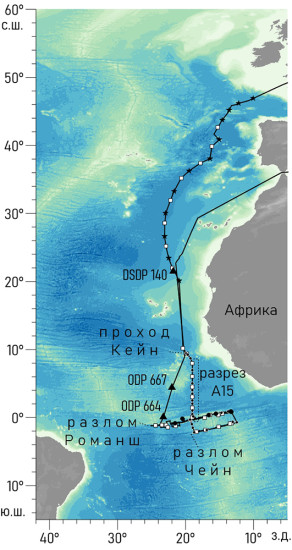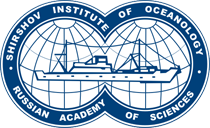 The 63rd voyage of PS Akademik Ioffe to the eastern tropical Atlantic (September 29, 2022 – December 7, 2022) has ended. The expedition was organized by the Shirshov Institute of Oceanology, Russian Academy of Sciences, with the participation of the Faculty of Geography of Moscow State University and the Federal Research Center of the Institute of Bio-Science Mining, Russian Academy of Sciences. The head of the expedition is the chief researcher of the IO RAS, DSc E.V. Ivanova.
The 63rd voyage of PS Akademik Ioffe to the eastern tropical Atlantic (September 29, 2022 – December 7, 2022) has ended. The expedition was organized by the Shirshov Institute of Oceanology, Russian Academy of Sciences, with the participation of the Faculty of Geography of Moscow State University and the Federal Research Center of the Institute of Bio-Science Mining, Russian Academy of Sciences. The head of the expedition is the chief researcher of the IO RAS, DSc E.V. Ivanova.
The scientific program of the expedition has been fully completed. It included:
seismoacoustic profiling and selection of cores of bottom sediments to study the seismoacoustic structure, composition and distribution of deep Quaternary deposits in the valleys of the Romansh and Chain transform faults, identification and correlation of seismoacoustic facies to establish the effect of bottom circulation on sedimentation, identification of sources of lateral and vertical sedimentation;
magnetic survey at the Romansh-Chain test site and part of the expedition route (including on seamounts) using modern digital equipment to determine the sources and nature of magnetic anomalies in regional tectonic structures;
hydrophysical measurements on sections Kane and A15 to study changes in the characteristics of AABW and NAGW;
study of the structure and transport of AABW in the Romansh and Cheyne transform faults as the most important mechanism of water exchange between the Western and Eastern Atlantic based on CTD sounding to the bottom and measurements of current velocities;
determination of the content of oxygen and biogenic elements, mainly in the AADW and SAGW layers;
measurements of parameters of the state of the surface mixed layer of the ocean, including temperature, salinity, hydrochemical parameters (oxygen, phosphorus, nitrates, nitrites, ammonium, silicates, pH);
incidental sampling of the surface water layer for analysis of the composition and abundance of phytoplankton and measurements of chlorophyll "a" of microplankton;
assessment of cloudiness and incoming flux of shortwave and longwave radiation along the route of the expedition in the Eastern Atlantic and the Mediterranean Sea;
assessment of the state of the sea surface using observations, navigational radar, wave buoy and satellite data along the route of the expedition in the Eastern Atlantic;
continuous record of cetaceans along the route of the vessel in the Eastern Atlantic and the Mediterranean Sea.
During the expedition, 7160 nautical miles were covered with the SES-2000 deep seismic profiler and 4000 nautical miles with the SeaPos2 magnetometer. Work was carried out at 74 deep-water stations (29 of them complex): 19 cores of bottom sediments were obtained, 30 soundings of the upper 50 m and 35 soundings of the water column from the surface to the bottom were performed using the SBE19plus V2 profiler with sampling by the SBE32 Carousel system from Niskin system bottle meters and velocity measurements currents using ACM Nortek Aquadopp 6000, 30 buoy stations were made with the drift of the Spotter wave buoy, passing observations of clouds, solar radiation, the state of the sea surface and marine mammals were carried out, surface water and phytoplankton sampling was carried out.
Made 30 reports at scientific seminars, read 7 popular science lectures. A day of science was held for the crew, excursions to the bridge and to the engine room for the scientific staff.
During the work at the Romansh-Chain test site, Akademik Iofe crossed the equator 18 times.
https://ioran.ocean.ru/en/index.php/novosti-instituta/1138-63rd-voyage-of-ps-akademik-ioffe-to-the-eastern-tropical-atlantic#sigProId3730b325c0




